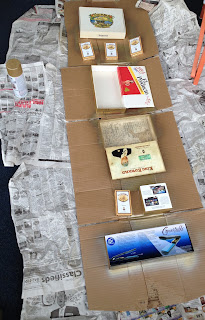Step 6: Were entirely ready to have God remove all these defects of character.
As I've said in prior posts, I prefer to think of my character "defects" more like "character defenses." I picked up these traits in order to survive stressful and/or traumatic experiences. I have simply outgrown their purpose and found newer and better tools to use.
The 6th step is about our readiness to have these character defenses lifted. We are not yet actually asking for them to be removed, simply examining our willingness.
Generally speaking, I recommend my sponsees review their fourth steps to reveal their character defects. But for the purposes of this group project, I brought a list of possible character defects with me and simply asked the group to select 5 of the defects to examine through this exercise.
Here is the list from which they chose their defects:
This list has been floating around 12-step rooms for over 50 years. The original author is unknown. But the on-line version where I downloaded this from can be found
here.
I like that this list provides not only the character flaws, but also corresponding character assets. I believe it is important to always keep a balanced perspective, instead of focusing 100% on the negative.
The first two rituals I will be describing were inspired by exercises in Stephanie S. Covington PhD's book
A Woman's Way through the Twelve Steps. Her Step Six exercises had a profound impact on me and on my recovery. In fact, her providing these rituals helped to expand my definition of what it means to "work the steps." It was this thinking-outside-the-box that eventually led to my exploration of art therapy as a means of working all 12 steps. I've made some minor changes to her 6th step rituals, as follows.
Ritual #1: Letting the Leaves Fall Where They May
Supplies needed:
- leaves from a beloved plant
- pen
- elevated place from which to drop the leaves (i.e. second story window, balcony, deck, roof)
This is my beloved plant. We have had a very special relationship over the years. This plant has been with me through a divorce, through the death of one of my dearest cats, through remarriage and the adoption of my current cats. I've used this plant for multiple sixth step rituals, as I will describe below.
I always choose leaves that have already turned yellow, out of compassion for my dear plant. But any leaves will serve the purpose. As all leaves are quickly biodegradable.
For the ritual, we simply wrote a single character defect on each leaf.
Then, standing in an elevated place, we released one leaf at a time, to fall where it may. It is always interesting to me to notice which defects are harder to let go of than the others.
Ritual #2: Stones in the Water
Supplies needed:
- stones
- sharpie marker - either black if the stones are light colored or silver if the stones are dark colored. Oil-based paint pens take longer to dry, but can appear more dramatic against the stone.
- a body of water into which the stones can be thrown (i.e. lake, river, ocean, pond, creek)
For this ritual, we wrote a single character defect on each stone.
Then, standing along a body of water (safely away from other people or animals), we threw the stones into the water - one at a time. Again, I always find it interesting to notice which stones I'm not ready to throw in and hang onto until the end of the ritual.
Ritual #3: The Writing in the Sand
Supplies needed:
- stick or other object to write in the sand with
- body of water where waves lap safely onto the shore (not recommended in areas prone to rogue waves)
This is a ritual that I have only performed on my own, not in the group setting. However, it could also be done with a group.
Find an area of the sand that is wet, where the waves still seem active. Using your stick, write your character defect in the sand near the water's edge. And wait.
This ritual is more close to reality in that you must wait for the defect to be lifted (or in this case, washed away). It happens in Higher Power's time (and the ocean's time), not in our time. There were times I barely finished writing the word before it got washed away (sometimes way before I was ready to let it go). Other times, I had to wait several minutes before the defect got washed away.
If you're self-conscious, you can look up the tide schedule. For highly populated beaches, you may want to choose to do this activity when the tide is coming in. This provides a greater confidence that you won't have to wait hours for the waves to wash your defect away.
What character defects are you ready to have lifted?



















































